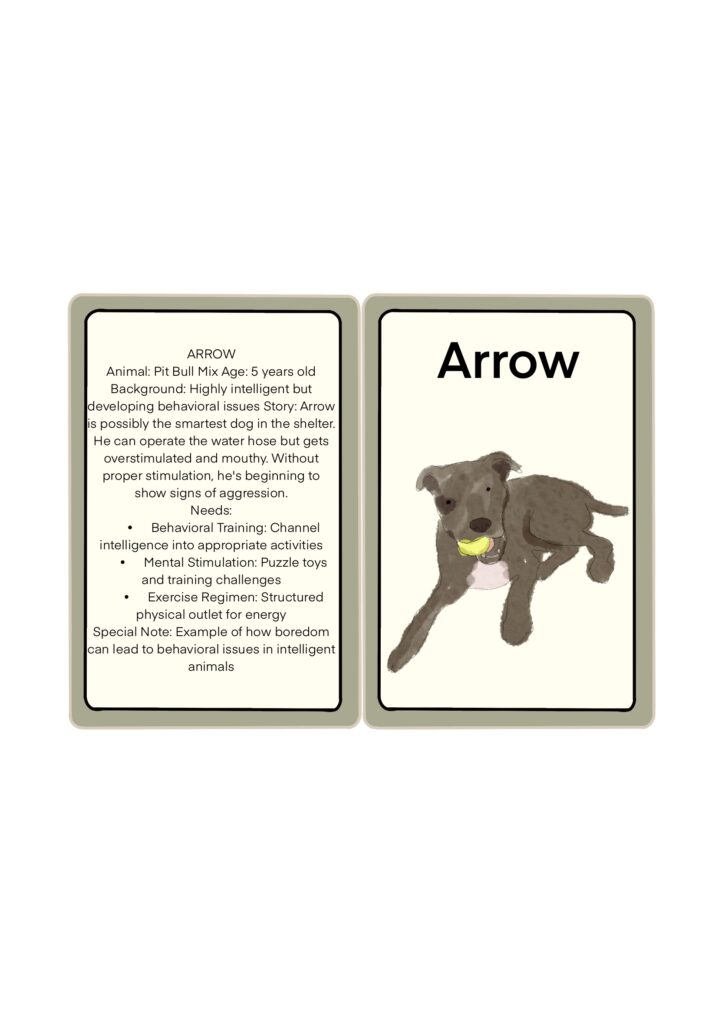
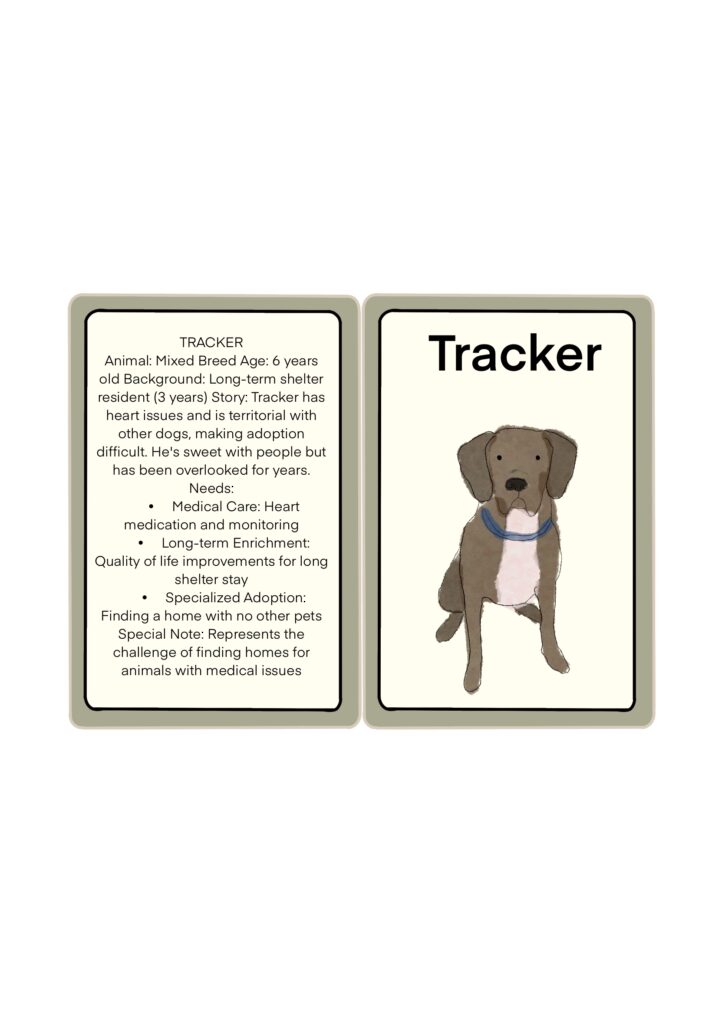
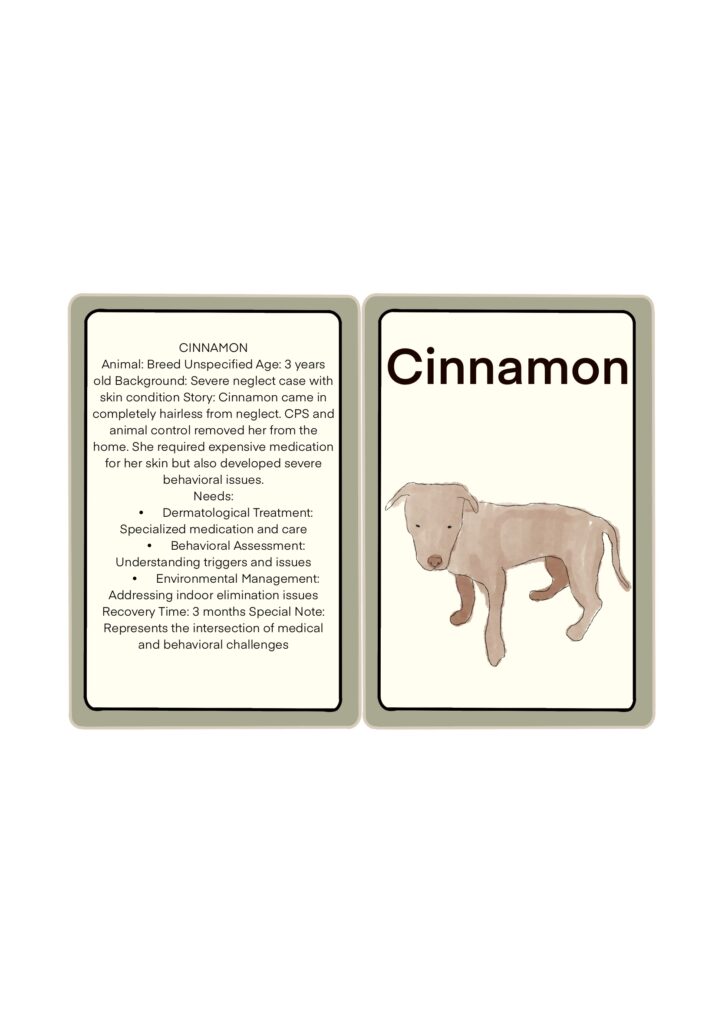
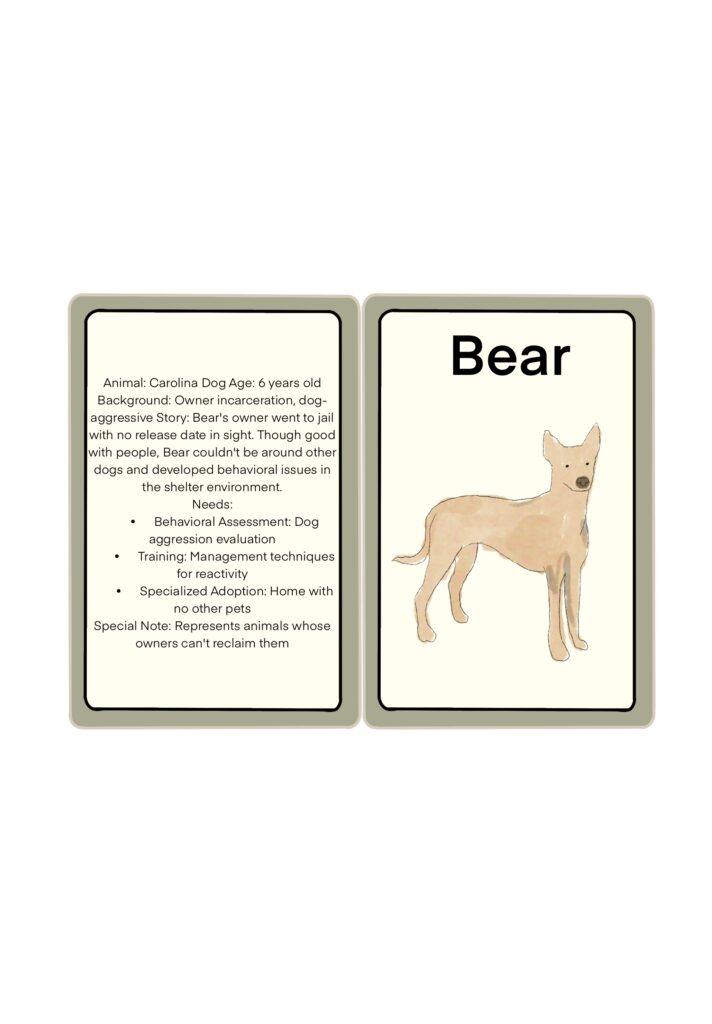
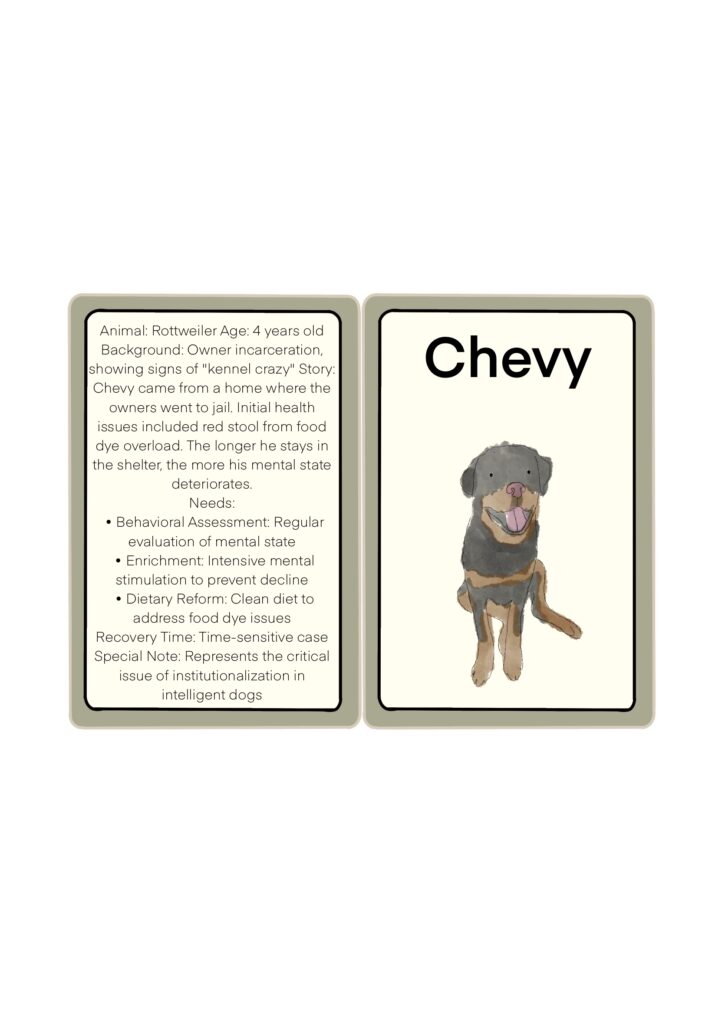
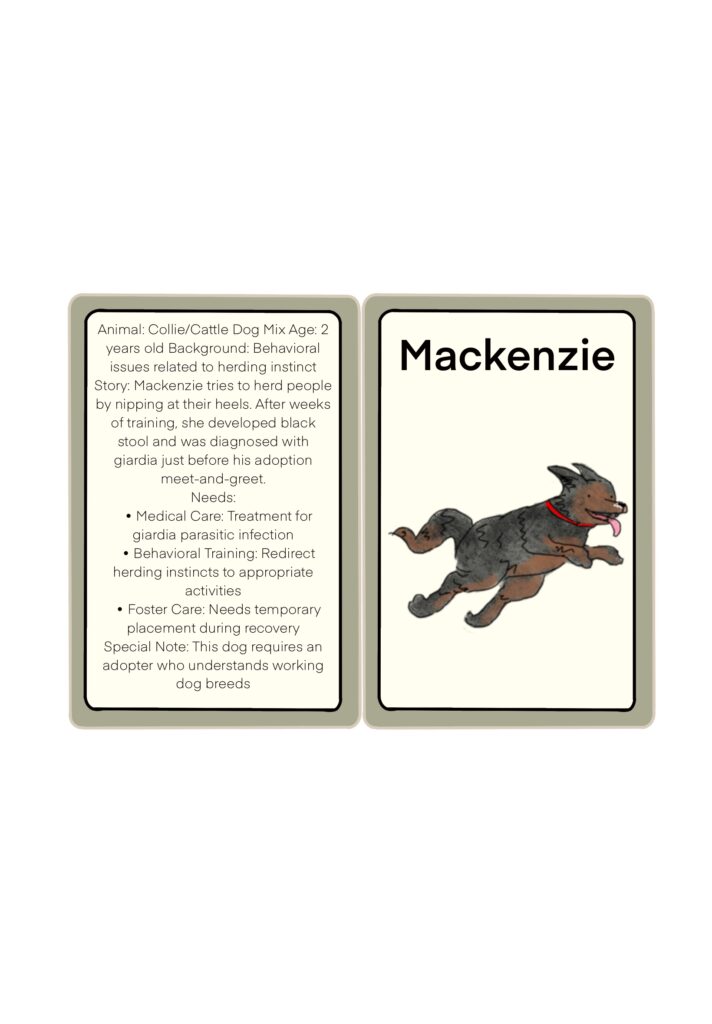
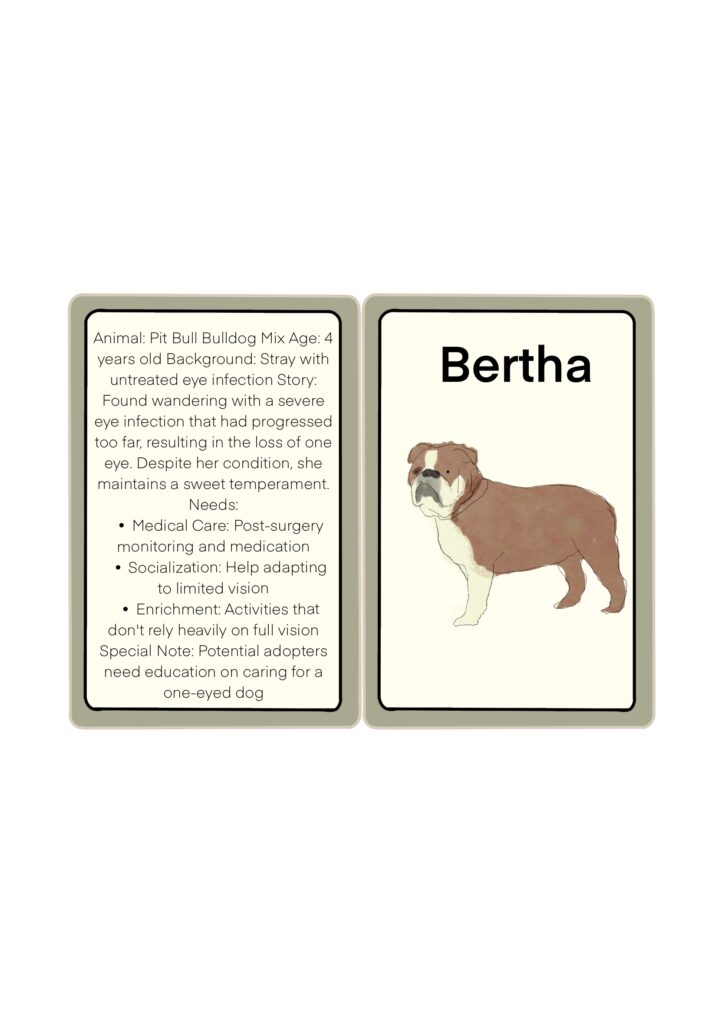
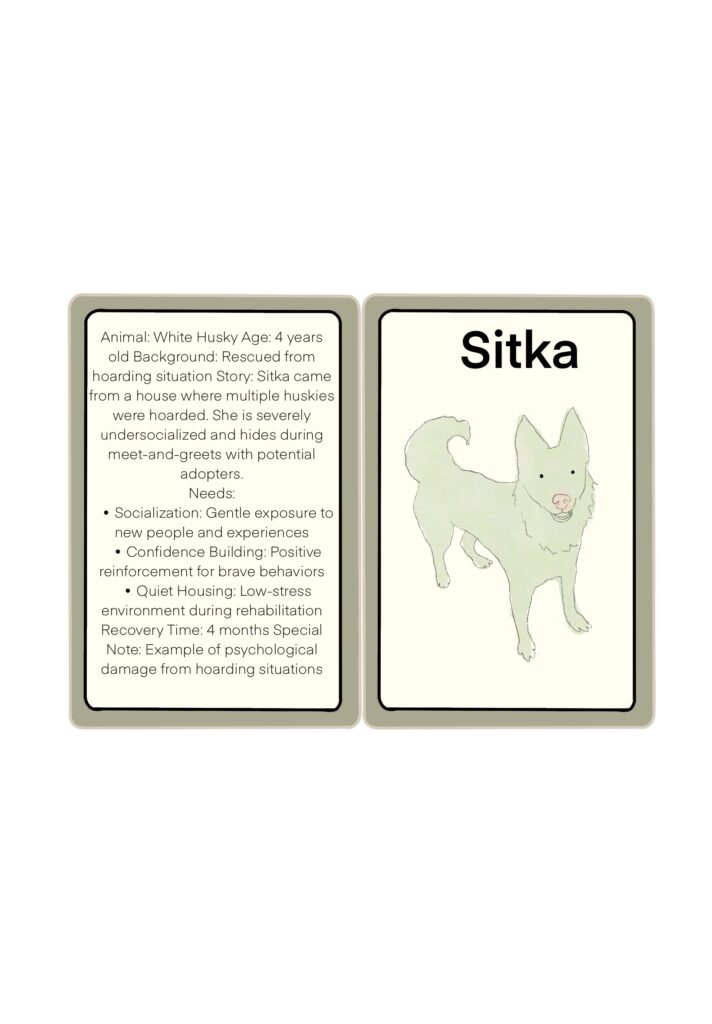
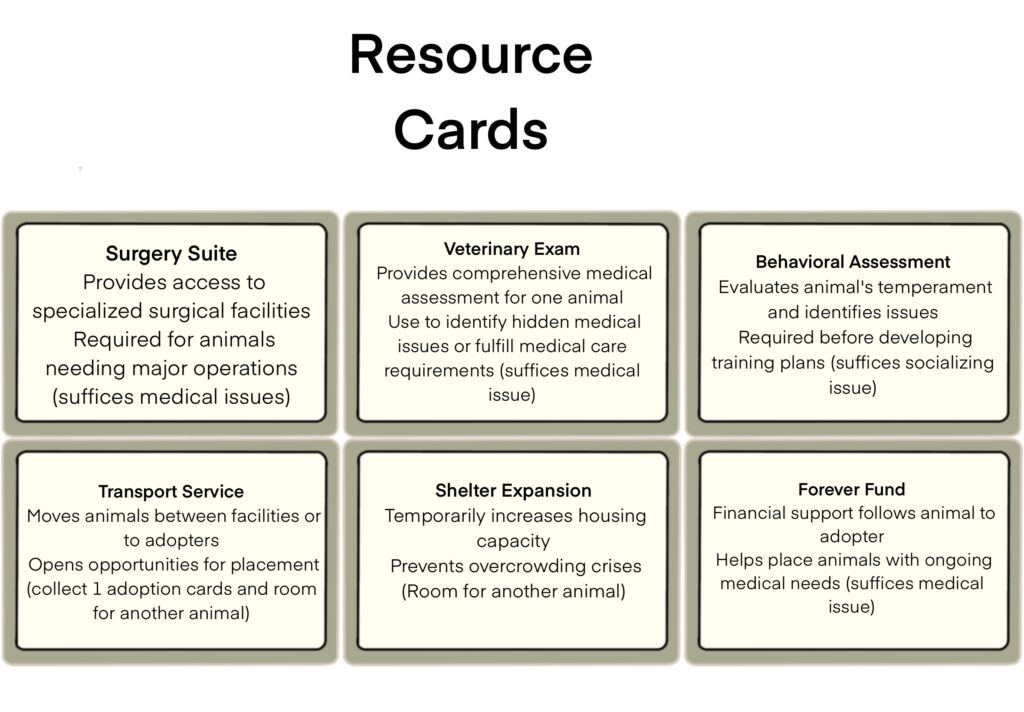

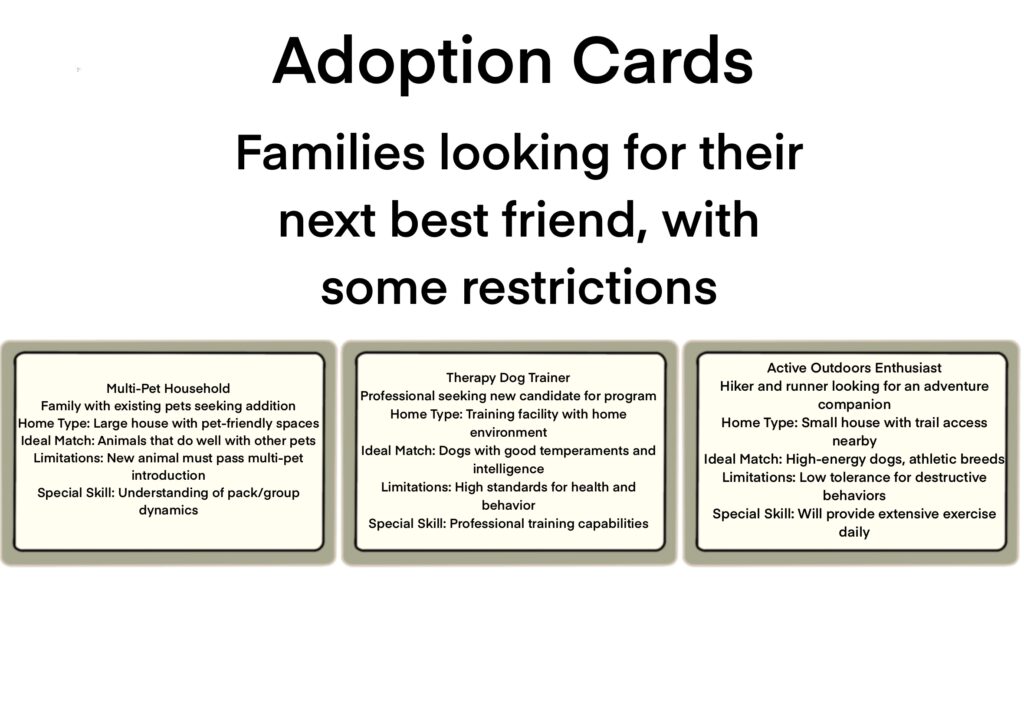
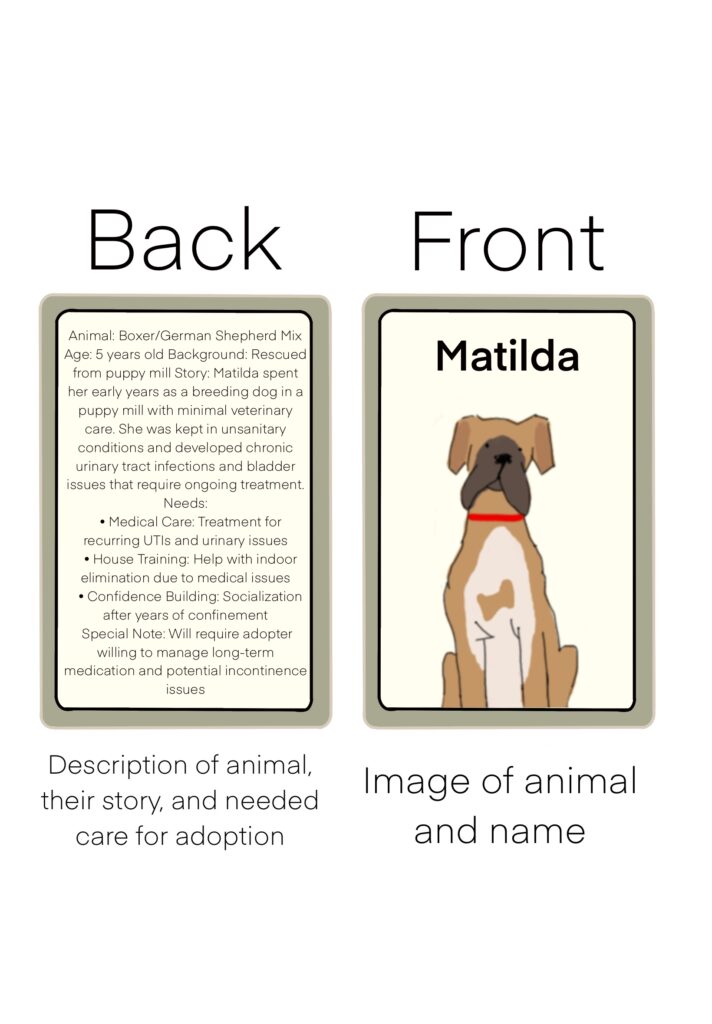
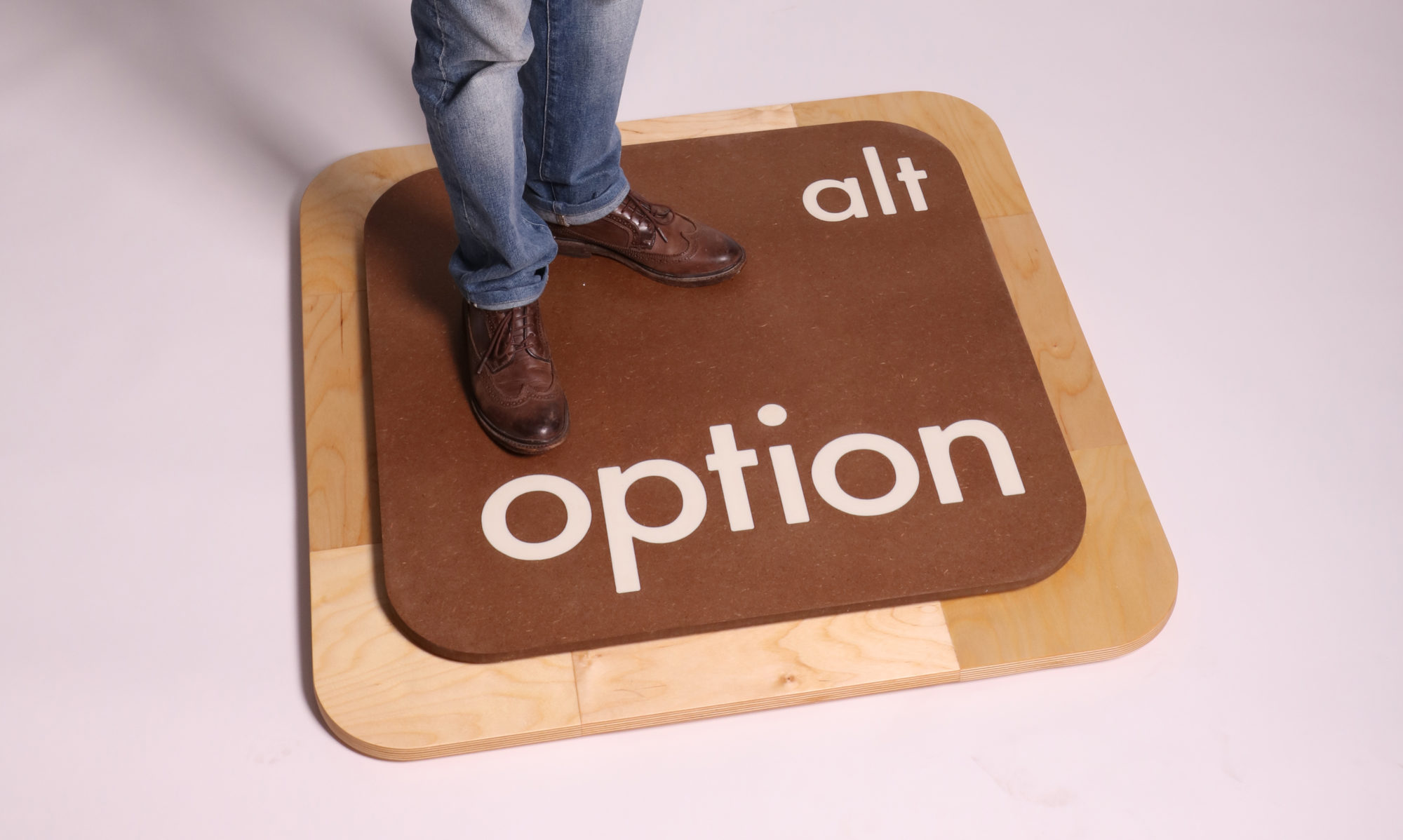
design courses, syllabi, schedules, resources and policies
Litter Patrol is an asymmetric board game where one player takes on the role of a Litterer while two others play as environmental defenders (a Civilian and an Officer) in a community setting. The game explores environmental stewardship through strategic gameplay that balances entertainment with educational value.
The game aims to raise awareness about the impact of littering on community spaces while creating an engaging play experience. Rather than being preachy, the game demonstrates consequences through mechanics that feel natural and strategic.
The initial design featured simple mechanics where the Litterer placed tokens and the Defenders removed them. Playtesting revealed this was too straightforward and favored the Defenders, making the Litterer role unsatisfying.
Challenge: Creating balanced asymmetric gameplay Solution: Enhanced the Litterer’s abilities with “Blend In” and “Sneak Littering” options, while adding restrictions to the Defenders
Added card systems for each player role but discovered the game lacked a connection to real-world scenarios. The environmental message felt forced and separate from the gameplay.
Challenge: Integrating educational content without sacrificing fun Solution: Developed the scenario system to create meaningful choices tied to everyday situations
Initial scenario design made winning too easy for the Defenders. The game became predictable after a few plays.
Challenge: Creating tension and replayability Solution: Adjusted winning conditions, introduced variable board setups, and added the “Public Opinion” and “Budget Constraints” trackers
The central game state tracker that responds to the presence of litter tokens on the board. Different litter types have varying impacts:
Health can be restored through cleanup actions, but at a slower rate than it can be depleted, creating strategic tension.
When a player lands on a scenario location, they activate a card presenting an everyday situation with environmental choices. Each player’s decision grants different advantages or disadvantages.
Show Image
The Fast Food Drive-Thru scenario illustrates how the system works:
Litterer:
Civilian:
Officer:
The Litterer aims to degrade the environment by strategically placing litter tokens across the board. Success comes through:
Victory Path: Drop environmental health below 20% through concentrated littering efforts, or maintain it below 30% for three consecutive rounds through consistent pressure.
The Civilian and Officer must coordinate their complementary abilities to protect the environment:
Victory Path: Maintain environmental health above 40% for 12 rounds through vigilant protection, or restore health to 90% through concentrated cleanup efforts.
Players establish their strategies while learning each other’s patterns. The Litterer typically gains an early advantage as Defenders need time to establish protection systems.
Tension builds as scenarios create pivotal moments. The environmental health tracker typically fluctuates between 40-70% during this phase as players execute their strategies.
The final rounds feature high-stakes decisions as players race toward their victory conditions. Special abilities saved for critical moments often determine the outcome.
The modular hexagonal tiles create variable setups for each game. Different zones feature distinct characteristics:
The physical design of components reinforces their function – litter tokens are small and numerous, while education and enforcement tokens are larger and more substantial, symbolizing their protective nature.
Scenarios represent everyday situations where environmental choices matter. When your character lands on or passes a scenario marker, follow these steps:
A hot day at the park with melting ice cream cones creates an opportunity for environmental choices.
Litterer Options:
Civilian Options:
Officer Options:
Players: Clarkie (Litterer), Emily (Civilian), Sarah (Officer) Game Duration: 47 minutes
Observations:
Player Feedback: “The tension was great in the middle game, but I felt too powerful at the start.” – Clarkie (Litterer) “I need more ways to counter the Litterer’s special abilities.” – Emily (Civilian) “The scenarios made me think differently about everyday situations.” – Sarah (Officer)
Adjustments Made:
Players: Dad(Litterer), Sarah (Civilian), Me (Officer) Game Duration: 52 minutes
Observations:
Player Feedback: “I had to think several moves ahead – it felt like chess!” – Amir (Litterer) “Coordinating with the Officer player created interesting social dynamics.” – Sarah (Civilian) The budget being constrained made me prioritize my actions. – Me (Officer)
If developing this game further, I would:
Litter Patrol succeeded in its core goal: creating an engaging game experience that naturally inspires environmental awareness through play rather than preaching. The design process reinforced that educational games work best when the message emerges organically from well-crafted mechanics rather than being superimposed onto gameplay.
Breaking the Cycle is a cooperative storytelling card game where players work together as a support network to help a survivor escape domestic violence and rebuild their life. The game creates a safe space to explore complex social issues while providing factual information about available resources and effective intervention strategies.
The game aims to increase awareness about domestic violence, develop empathy for survivors, and educate players about warning signs and support options. By placing players in the role of supporters rather than survivors, the game avoids trauma exploitation while still creating powerful emotional investment in positive outcomes.
The initial design featured a linear progression track and straightforward challenges. Early testing revealed this approach felt too simplistic and deterministic for such a complex issue.
Challenge: Creating gameplay that respected the gravity of domestic violence while remaining engaging Solution:Introduced branching paths on the Journey Track and more nuanced Challenge cards
Players reported discomfort with explicit descriptions of abuse in early versions, which detracted from learning objectives.
Challenge: Finding appropriate ways to represent abuse without graphic descriptions Solution: Shifted focus to warning signs and patterns rather than incidents, used symbolic rather than explicit representations
Testing revealed players sometimes prioritized “winning” over learning, occasionally missing educational opportunities.
Challenge: Balancing gameplay with educational content Solution: Integrated “Moment of Reflection” cards and redesigned the scoring system to reward learning and thoughtful discussion
Each player takes on a specific support role (Friend, Family Member, Counselor, Legal Advocate, etc.) with unique abilities:
The design ensures that success requires cooperation between different types of support, reflecting reality.
As the game progresses, survivors collect Empowerment tokens through successful resolution of challenges. These tokens can be spent to:
This system mechanically represents the growing agency of survivors as they progress through their journey.
When facing challenges, players:
Guide the survivor through their journey from crisis to safety and ultimately to a new beginning with increased agency and empowerment.
Victory Path: Successfully navigate the Journey Track by overcoming challenges through appropriate support, while collecting at least 3 Empowerment tokens that represent the survivor’s growing independence and agency.
Players select a Survivor Profile card that outlines a specific situation. They then receive their role cards, initial resources, and establish the Journey Track according to the profile’s specifications.
The early game represents the immediate crisis period where safety is the primary concern:
As play progresses, challenges shift toward rebuilding stability:
The final stage focuses on long-term independence and healing:
Color-coded by type (Safety, Housing, Legal, Emotional, etc.) with clear iconography. Cards include:
Represent different ways players can intervene, with:
Tangible resources that strengthen support actions:
A board showing the survivor’s path from crisis to new beginning, with:
When facing a Challenge card, players must work together to provide appropriate support. Follow these steps:
The survivor needs to find safe housing away from their abuser, but has limited income and a pet they won’t leave behind.
Challenge Difficulty: 4 Support Types Needed: Practical, Financial
Possible Support Actions:
Potential Resources:
Success Result: Players played 2 matching Support Actions and 2 Resources for a Support Value of 4, resulting in a Partial Success. The survivor advances 1 space on the Journey Track.
Participants: 4 players Duration: 67 minutes
Observations:
Key Feedback: “The mechanics effectively show how different types of support must work together.” – Participant A “Some Challenge cards need more nuance about why survivors might return to abusers.” – Participant B “The Empowerment system feels meaningful but needs more clarity.” – Participant C
Adjustments Made:
Participants: 5 players (university students with some knowledge of domestic violence) Duration: 75 minutes
Observations:
Key Feedback: “I never understood why someone would stay before, but now I see how complicated these situations are.” – Participant D “The cooperative nature really drives home how important community support is.” – Participant E “The factual information on the cards was eye-opening.” – Participant F
Adjustments Made:
If developing this game further, I would:
“Breaking the Cycle” successfully achieves its goals of creating awareness, developing empathy, and providing education about domestic violence through engaging cooperative gameplay. By putting players in the position of supporters rather than survivors, the game creates emotional investment while avoiding exploitation of trauma. The iterative design process, guided by expert input, resulted in a game that handles sensitive material respectfully while still creating meaningful play experiences.
Second Chance Sanctuary is a cooperative board game where players take on roles as animal welfare workers in an animal shelter. Players work together to rescue, rehabilitate, and rehome abused, neglected, or abandoned animals. The game is designed for animal lovers, board game enthusiasts, and individuals interested in social impact gaming, ages 12 and up. With its educational component highlighting real animal welfare issues, Second Chance Sanctuary balances challenging gameplay with heartwarming stories of animal rescue.
Second Chance Sanctuary is a cooperative resource management game where players work together to save as many animals as possible within the constraints of a busy animal shelter.
Our initial design focused heavily on the educational aspects of animal welfare but lacked engaging gameplay. The first prototype included:
Challenges: Playtesting revealed that the players appreciated the theme, the gameplay is truly empathetic and could have some great game play but needed some work in the challenges cards.
We introduced specialized roles and expanded the animal attributes to create more varied gameplay experiences:
Challenges: The game became too complex when it came to the cards, with too many elements to track simultaneously. Players felt overwhelmed by the number of decisions required each turn.
We streamlined gameplay while maintaining depth:
Challenges: The balance between difficulty and player agency needed adjustment. Players felt that bad luck with the challenge deck could make winning impossible.
Our final iteration focused on balance and emotional investment:
The core mechanic of Second Chance Sanctuary revolves around a multi-step rehabilitation process:
Players must carefully manage their hand of Resource Cards to address the most urgent needs:
The Challenge Phase introduces unexpected difficulties that test the team’s resilience:
Successfully rehabilitate and rehome 5 animals by:
Players win when they’ve successfully placed 5 animals into Adoption Families area, representing animals that have been fully rehabilitated and matched with forever homes.
Players lose if:
Each round consists of six distinct phases:
Detailed cards that tell each animal’s story:
Tools and services needed to help animals:
Unexpected difficulties that arise:
Potential forever homes for rehabilitated animals:
The rulebook excerpt below demonstrates our approach to clear, concise instructions that maintain the game’s emotional core:
In this cooperative game, you and your fellow players take on the roles of animal welfare workers at Second Chance Sanctuary, a shelter dedicated to rescuing, rehabilitating, and rehoming animals that have experienced abuse, neglect, or abandonment.
Your mission is to work together to save as many animals as possible while managing limited resources and facing unexpected challenges. Every animal has a unique story and specific needs that must be addressed before they can find their forever home.
Starting with the first player and proceeding clockwise, each player may play Resource Cards from their hand to help animals in the shelter:
Example: Brooklyn the Belgian Malinois/German Shepherd has three needs: Medical Care, Trust Building, and Basic Training. A player could play the “Veterinary Exam” Resource Card to address her Medical Care need.
Participants: 4 players Feedback:
Action Items:
Participants: 5 players Feedback:
Action Items:
Participants: 3 players Feedback:
Action Items:
Participants: 6 players Feedback:
Based on our experience developing Second Chance Sanctuary and feedback from playtesters, we’ve identified several opportunities for future development:
Second Chance Sanctuary has evolved from a simple educational concept into a sophisticated board game that balances mechanical depth with emotional storytelling. Through four iterations of design and testing, we’ve created an experience that engages players while raising awareness about important animal welfare issues.
I played Hues and Cues a couple weeks go, and I very much enjoyed it. I really had a hard time coming up with words for the particular colors. I saw that I had an easier time with certain shades at first, but it became harder to come up with words after a while though because it became a bit repetitive with the color picks. So as much as I loved the game and would maybe play it again at a family party, it wasn’t my favorite game in the entire world.
I had some people play my animal shelter game, where players work as a team of animal welfare advocates managing an animal rescue organization. their goal is to successfully rescue, rehabilitate, and rehome animals who have experienced abuse or neglect.
One thing I noticed is that I did not add in the team aspect as much as I wanted to, I will either have to fix it or make it so all the shelters are in competition, which I would like to avoid.
I based the game off of real animals that are, or were sheltered as Washington Humane, so I believe I reached the empathetic idea I was going for, it was very sad. I even brought in pictures of all of the animals so they could visualize who they were taking care of. Id like to create new cards that have the pictures of the dogs on one side, and their description and story on the other side.
I need to set up a new system where people only get a challenge card everyone once in a while and not every turn. Though people enjoyed that there was a challenge, it was just a bit too hard.
Overall, I believe that this game could be made into something bigger with its empathetic playthrough but needs some touching up.
If you played let me know what you think and if anything needs fixed up!
An asymmetric board game where environmental defenders (Civilian and Officer) compete against a Litterer to protect community spaces. Features balanced gameplay with meaningful environmental messaging.
When players land on scenario locations, they face environmental choices:
Recently, the Elder Scrolls got an update of Oblivion: Remastered, developed by Virtuos and Bethesda Game Studios and I thought I would talk about it a little bit and give it a review.
Some back story, Oblivion OG released in 2006 and was a huge hit, especially in my family. The graphics and game play were great especially with the open world concept that it followed. Yes, Oblivion may be known for its hilarious glitches, limited voice acting (even over recorded lines that weren’t clipped lol) , and their now-a-days not so great quality ( the green hue that you see in the game) but The Elder Scrolls series is something unmatched, and hearing that they were remastering one of the best games in the series got a lot of the fan base excited and nervous. It was one of the first games I fell in love with on the PS3 and XBOX 360, so I am eagerly writing this review.
Honestly, Bethesda is known to push back dates, very often. There have been rumors of an Elder Scrolls 6 since 2014, and they rarely talk about it. But when they shadow dropped Oblivion Remastered, the whole world had officially shifted its gaze back to our good old Oblivion. Bethesda released a statement talking about how much they wanted to keep so much of the game, but bring it up to todays standards of graphics, and it has truly lived up to it. They have kept all original dialog, voice actors, storylines and so much more which has made people thrilled to keep going back in for more. If you haven’t played the original, I can honestly say (even though I love modded OG Oblivion) you don’t have to worry about playing the OG first, its all, and more in the remastering. And yes.. a majority of the game still has it’s glitches (thank you Bethesda I feel right at home hehe).
Bethesda and Virtuos collabed in 2021 to use Unreal Engine 5 to update only a bit of the game play, but a majority of the graphics. The landscapes are not even compared to Skyrim’s anymore (which honestly hurts to say, but needed to be said.) they are beautiful, the water, animals, and people are so much more life like now, it’s good that they’ve gotten the love they’ve so deserved.
I haven’t played enough through the remaster to tell you everything, but I can tell you that it has a whole new life to it that gives goose bumps down your arms feeling not only at home, but a new love put into it.
Highly rated 10/10 game, please go buy it if you haven’t and if you love fantasy based games like me, and if anyone has play through it more than I have please put your input in the comments!! I would love to hear more thoughts about how others feel.
“go back to the chess club” -todd howard
This card game centers on animal rescue, rehabilitation, and advocacy. Here’s a more detailed breakdown:
Players work as a team of animal welfare advocates managing an animal rescue organization. Your goal is to successfully rescue, rehabilitate, and rehome animals who have experienced abuse or neglect.
Each animal has specific needs based on their situation:
The game ends after a predetermined number of rounds. Players tally:
Successfully rehabilitate and find homes for 8 animals before the shelter becomes full.
The game strikes a balance between showing the reality of animal abuse while focusing on the positive impact of intervention, creating a challenging but ultimately hopeful experience that educates players about this important issue.
I apologize for the video quality but I thought this was so ironic, Slim Jim just released an game advertising their products. I might download it, let me know if anyone has played it yet!
I absolutely loved this game. It taught the that everyone has different opinions and different experiences in life and provoked empathy! In three words I would describe this game as through-provoking, pretty, and empathetic. We had some great conversations and I appreciate that there is a “bad” card to roll for Game design, as it is relevant to us. The only thing I would change about the game would be the use of the dice, but even then the game was easy to comprehend and play easily and I would play it again!